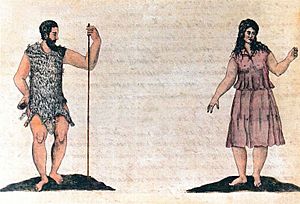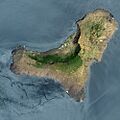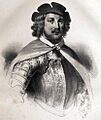Bimbache facts for kids

Painting of Bimbache by Leonardo Torriani, 1592
|
|
| Total population | |
|---|---|
| Unknown – | |
| Regions with significant populations | |
| Religion | |
| Animism | |
| Related ethnic groups | |
| Berber · Riffian · Guanches |
The Bimbache (also called Bimbape) were the first people to live on the island of El Hierro. This was before the Spanish took control of the Canary Islands between 1402 and 1496. The Bimbache were one of many native groups in the Canaries. They had family and cultural ties to the Berber people from North Africa. They were connected to other original peoples of the Canary Islands.
The Bimbache called their island Eseró or Heró. The name "Bimbache" means "Sons of the Sons of Tenerife". This suggests they might have come from the Guanches. The Guanches were the ancient people of the island of Tenerife.
Contents
How the Bimbache Lived
The Bimbache people lived a simple life. They mostly raised animals like cows, goats, sheep, and pigs. They also grew some grains and used resources from the sea.
Since there were no regular trade ships, the Bimbache traded goods among themselves. They exchanged local products with each other. Land and other shared resources were managed fairly. Decisions were made in meetings led by a mediating king. This was a system where everyone had a say. The king made sure things were fair and democratic.
El Hierro's Unique Divisions
Unlike other Canary Islands, El Hierro did not have different areas or territories. The whole island was managed as one.
The Spanish Arrive on El Hierro
The Spanish took control of El Hierro in late 1405. This was led by Jean de Béthencourt. He promised the Bimbache people that they would remain free. Because of this promise, the small native population did not fight back.
Sadly, this promise was later broken. De Béthencourt's son sold many Bimbache people into slavery. The island was then settled by people from Spain and France.
Over time, the Spanish rulers changed how the island was run. They gave land and trading rights to a few people. This was part of a feudal system. Also, the native Bimbache religion, which honored nature, was suppressed. This was done to introduce Christianity to the island.
Some Bimbache people were taken to Spain to work as slaves. Later, they were recognized as free people again. Many were then able to return to El Hierro. The island also saw new settlers from France and Galicia.
Bimbache Beliefs and Gods
Each Canary Island had its own gods. But they all shared some ideas about nature's power. On El Hierro, there were two kind gods. These were the god Eraorahan and the goddess Moneiba. There was also a third god, Aranfaybo. People prayed to Aranfaybo when they were in great trouble.
Where the Bimbache Came From
Scientists have studied the remains of Bimbache people. They looked at bones from a burial site on El Hierro. This helped them learn about the Bimbache's family history.
The studies showed that the Bimbache had ties to North Africa. Some of their family lines are common there. Other lines are more common in Europe. This suggests that the Bimbache might have come from different groups. They likely arrived in the Canary Islands in waves from North Africa.
Interestingly, the studies also showed that one specific maternal family line was very common. This might mean that the Bimbache society was matrilineal. This means family lines were traced through the mother's side.
Images for kids
See also
 In Spanish: Bimbache para niños
In Spanish: Bimbache para niños



